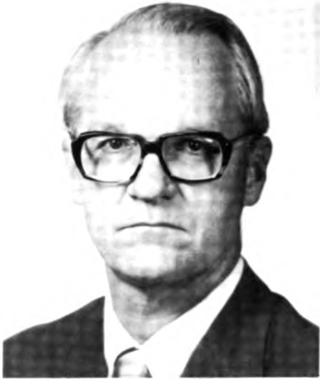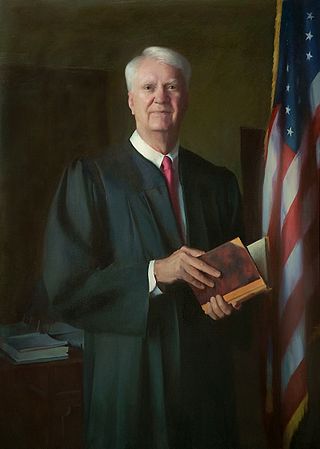
The United States Court of Appeals for the District of Columbia Circuit is one of the thirteen United States Courts of Appeals. It has the smallest geographical jurisdiction of any of the U.S. courts of appeals, and it covers only one district court: the U.S. District Court for the District of Columbia. It meets at the E. Barrett Prettyman United States Courthouse in Washington, DC.
During President Bill Clinton's first and second terms of office, he nominated 24 people for 20 federal appellate judgeships but the nominees were not processed by the Republican-controlled Senate Judiciary Committee. Three of the nominees who were not processed were nominated after July 1, 2000, the traditional start date of the unofficial Thurmond Rule during a presidential election year. Democrats claim that Senate Republicans of the 106th Congress purposely tried to keep open particular judgeships as a political maneuver to allow a future Republican president to fill them. Of the 20 seats in question, four were eventually filled with different Clinton nominees, fourteen were later filled with Republican nominees by President George W. Bush and two continued to stay open during Bush's presidency. Senator Harry Reid, the Democratic leader of the United States Senate during the 110th Congress, and Senator Patrick Leahy, the Democratic leader of the Senate Judiciary Committee under Reid, repeatedly mentioned the controversy over President Clinton's court of appeals nominees during the controversy involving the confirmation of Republican court of appeals nominees during the last two years of Bush's second term. Republicans claimed that Democrats were refusing to confirm certain longstanding Bush nominees in order to allow a future Democratic president in 2009 to fill those judgeships.
During President George W. Bush's two term tenure in office, a few of his nominations for federal judgeships were blocked by the Senate Democrats either directly in the Senate Judiciary Committee or on the full Senate floor in various procedural moves, including the first use of a filibuster to block a Federal Appeals Court nominee. Republicans labeled it an unwarranted obstruction of professionally qualified judicial nominees.
During George H. W. Bush's term in office as the president of the United States of America, he nominated 11 individuals for 10 different federal appellate judgeships who were not processed by the Democratic-controlled Senate Judiciary Committee. The Republicans claim that Senate Democrats of the 102nd Congress on purpose tried to keep open particular judgeships as a political maneuver to allow a future Democratic president to fill them. All 10 of the judgeships were eventually filled with Clinton nominees, although one nominee, Roger Gregory, was nominated by Clinton and then renominated by President George W. Bush. None of the nominees were nominated after July 1, 1992, the traditional start date of the unofficial Thurmond Rule during a presidential election year. Senator Orrin Hatch, the Republican leader of the Senate Judiciary Committee during the 106th Congress mentioned the controversy over President George H.W. Bush's court of appeals nominees during the following controversy involving the confirmation of any more Democratic court of appeals nominees during the last two years of President Bill Clinton's second term.

Howard Frederic Sachs is a senior United States district judge of the United States District Court for the Western District of Missouri. He also is a former federal judicial nominee to the United States Court of Appeals for the Eighth Circuit.
During President Jimmy Carter's presidency, he nominated four people for four different federal appellate judgeships who were not processed by the Democratic-controlled Senate Judiciary Committee before Carter's presidency ended. None of the four nominees were renominated by Carter's successor, President Ronald Reagan. Three of the nominees who were not processed were nominated after July 1, 1980, the traditional start date of the unofficial Thurmond rule during a presidential election year. All four seats eventually were filled by appointees of President Ronald Reagan.
During President Ronald Reagan's presidency, he nominated two people for the Supreme Court and at least twelve people for various federal appellate judgeships who were not confirmed. In some cases, the nominations were not processed by the Democratic-controlled Senate Judiciary Committee before Reagan's presidency ended, while in other cases, nominees were rejected by the Senate Judiciary Committee or even blocked by unfriendly members of the Republican Party. Three of the nominees were renominated by Reagan's successor, President George H. W. Bush. Two of the nominees, Ferdinand Francis Fernandez and Guy G. Hurlbutt, were nominated after July 1, 1988, the traditional start date of the unofficial Thurmond Rule during a presidential election year. Eight of the thirteen seats eventually were filled by appointees of President George H. W. Bush.

John Robert Gibson was a United States circuit judge of the United States Court of Appeals for the Eighth Circuit and a United States district judge of the United States District Court for the Western District of Missouri.

Richard Mansfield Bilby was a United States district judge of the United States District Court for the District of Arizona.
Harry Walker Wellford was a United States circuit judge of the United States Court of Appeals for the Sixth Circuit and a United States district judge of the United States District Court for the Western District of Tennessee.
During President Richard Nixon's presidency, federal judicial appointments played a central role. Nixon appointed four individuals to the Supreme Court of the United States in just over five and a half years.
During President Lyndon B. Johnson's presidency, federal judicial appointments played a central role. Johnson appointed Abe Fortas and Thurgood Marshall to the Supreme Court of the United States in just over five years as president.
Elizabeth Anne Kovachevich is a senior United States district judge of the United States District Court for the Middle District of Florida.
Andrew Leon Thomas Jefferson Jr. was an American lawyer, a federal prosecutor, a Texas judge and a federal judicial nominee to the United States Court of Appeals for the Fifth Circuit. "The Judge", as he was affectionately known in the Houston community long after his tenure on the bench, was the first black judge above the municipal level in the state of Texas since the United States reconstruction era.

James Parker Jones is an American lawyer and jurist serving as a senior United States district judge of the United States District Court for the Western District of Virginia. He served as a judge of the United States Foreign Intelligence Surveillance Court from 2015 to 2022. He served as a judge of the United States Alien Terrorist Removal Court from 2016 to 2021.
U.S. President Barack Obama nominated over 400 individuals for federal judgeships during his presidency. Of these nominations, Congress confirmed 329 judgeships, 173 during the 111th & 112th Congresses and 156 during the 113th and 114th Congresses.
Donald Trump, President of the United States from 2017 to 2021, entered office with a significant number of judicial vacancies, including a Supreme Court vacancy due to the death of Antonin Scalia in February 2016. During the first eight months of his presidency, he nominated approximately 50 judges, a significantly higher number than any other recent president had made by that point in his presidency. By June 24, 2020, 200 of his Article III nominees had been confirmed by the United States Senate. According to multiple media outlets, Trump significantly impacted the composition of the Supreme Court and lower courts during his tenure.

Raúl Manuel Arias-Marxuach is the Chief United States district judge of the United States District Court for the District of Puerto Rico.
Deaths of United States federal judges in active service have profound political and procedural effects. Due to their implications for the political composition of the courts on which they serve, they can result in unexpected political conflicts regarding appointments to fill those seats. Such incidences can also disrupt the operations of the court with respect to active cases assigned to the deceased judge, and with opinions written by the deceased judge but not yet distributed. Historically, the rate of judges dying in active service was highest in the early days of the country, but declined sharply as lifespans increased, and as various legislation was introduced first allowing retiring judges to collect a pension, and later allowing judges to transition from active service to senior status, continuing to do judicial work in a semi-retired state.







